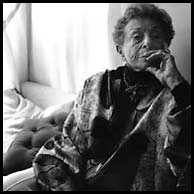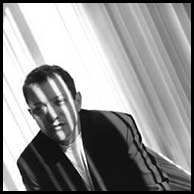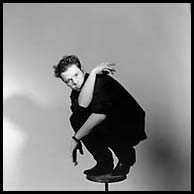| |
Interview
with Paul Waldman
(Continued
from page two)
What
is your background in photography?
I had a girlfriend - Carolyn, an aerial photographer - who got me
shooting with my father's vintage 35mm Nikon Nikomat. Since then
I have used Nikon’s N series cameras as well as the Canon EOS 1.
My favorite is the medium format Hasselblad. The Hasselblad’s 6cm
x 6cm square format is the easily the most challenging and rewarding
of all the camera systems I’ve worked with. Hasselblad uses Carl
Zeiss optics for all their lenses. Zeiss glass was a decisive reason
for going with Hasselblad. I worked as an independent model scout
with Elite New York, a freelance fashion photographer, and as managing
editor for ZONE, an arts and culture magazine. I used the time at
Zone to refine my ability as an editorial portrait photographer,
photographing and interviewing artists and celebrities. After I
left ZONE, I founded the Living American Master Photographers Project.
The LAMPP is a convergence of my core interests and abilities. As
a photographer, I'm hoping my LAMPP work will lead to new commercial
editorial assignments. I look forward to broadening my editorial
portfolio.
What
brought you to Arizona?
My family moved from New York when I was young so I grew up in Arizona.
After college I lived in Del Mar for a few years doing fashion shoots
and networking which ultimately took me to New York. When I lived
in New York's Greenwich Village, I used to go up to the roof of
my building on summer nights, just to wrap my eyes around the night
sky. It seems every time I leave Arizona, its expansive sky draws
me back.
What's
next with the LAMPP project? Who do you want to photograph next?
I was recently approached by Haim Ariav of the a21group. It was
the beginning of a wonderful relationship culminating in a21group's
sponsorship of the LAMPP's 10th Anniversary Online Exhibit. They've
done a wonderful job creating an awareness in the community for
the project. Through to June 2002, every four months a new series
of LAMPP participants will be exhibited. We expect some great exposure
for the LAMPP at Photo Plus Expo East. It is the biggest photo industry
trade convention, held annually in November at New York’s Jacob
Javits Convention Center. Haim Ariav, of a21group is working personally
with Richard Schleuning at Victor Hasselblad to create a print exhibit
space at their booth this year. If all goes as planned, some of
the finest living American master photographers will be stopping
by Hasselblad to see their latest offerings and to check out the
LAMPP exhibit.
To this end, Kodak played a pivotal role. The LAMPP standards require
that I pay special attention to the quality of project. The LAMPP
is entirely shot and printed on Kodak film and paper. We wouldn't
have a display at Photo Plus Expo East if it wasn't for people like
Mary Ann Semenko at Kodak, who arranged printing of the LAMPP images.
A new website is currently under development at www.thelampp.com.
For the future, a LAMPP television series on contemporary American
photography is being actively pursued as well as an interactive
DVD, multi-media CD ROM, and an archival book series.
I hope to make the LAMPP's interactive DVD using Apple's iDVD software
and their new Superdrive. I love my Mac! It may seem trivial, but
making the project fun has made all the difference. The LAMPP has
a strong education message. I’m hoping to combine resources with
the Institute for Studies in the Arts (ISA) at Arizona State University,
and develop an interactive text series for students interested in
photographic careers as well as inviting LAMPP participants for
semester residencies. The LAMPP archive is constantly growing. We’re
moving towards becoming a non-profit organization. New content is
always in the works. Current priorities include Eve Arnold, Richard
Avedon, Susan Meiselas, Roy DeCarava, Albert Watson, Irving Penn,
Herb Ritts, Cindy Sherman, Cornell Capa, Leonard Freed, Herman Leonard,
and Annie Leibovitz among others.
|
|
|

Ruth
Bernhard, 1991
©Paul
Waldman

Matthew Rolston, 1994
©Paul
Waldman

Hans
Neleman , 1993
©Paul
Waldman |
|





